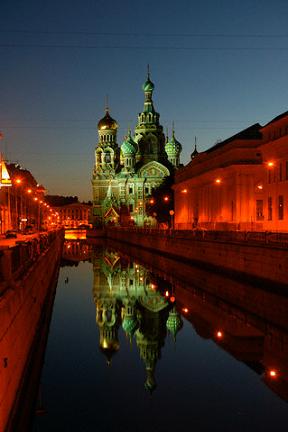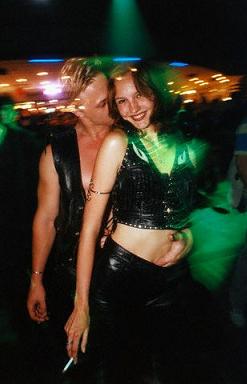Notes from the Overground
EGO Magazine |

By PARAG KHANNA
The capitalist conquest of Russia has not been pretty, but it has certainly been quick.
I came to Russia with many questions on my mind: What impact does Russian president Putin’s increasingly authoritarian style have on the average citizen? Will Russia favor America, Europe or China as a central ally ten years from now? Why do so many mafiosi drive Alfa Romeos when they can surely afford better? These and other concerns vexed me as I began my first foray into the “riddle wrapped in a puzzle wrapped in an enigma,” as Churchill famously described Russia.
My way of getting acquainted with a city is to ditch my bags in the hotel, throw on some running shoes and go for a meandering jog. On a quiet Sunday afternoon, when many Russians were off at their dachas, I covered a sizeable patch north of the Kremlin, running past the fabled Bolshoi (literally meaning “big”) theatre, Lubyanka Square and through several upscale neighborhoods. Vast construction projects are still common in post-communist societies today—Berlin, for example, is the biggest Baustelle next to Shanghai—but the giant advertisements for video games, electronics and cars draped around each of them are a spectacular eyesore.
Towards the evening I and my companion headed out for a tour of the city, driving along the Moskva River past Gorky Park and the absurd Christopher-Columbus-turned-Peter-the-Great monument, an aesthetically challenged project salvaged by Moscow Mayor Yuri Luzhkov out of misguided loyalty to its sculptor Tsereteli. Luzhkov, the energetic man synonymous with Moscow’s renaissance, enjoys cordial relations with Putin, with whom he also shares a certain management style.
The Ritz Carlton hotel to be erected adjacent to the Hotel Metropol and across from the Bolshoi is sure to be the crowning achievement in his project of rococo nationalism.
After a scrumptious dinner at the stylish, over-priced and virtually empty fusion restaurant Hoa, my friend and I got dropped off near one of Moscow’s most expensive yet inexclusive gentlemen’s clubs, Night Flight, which boasts 1000-ruble carpaccio appetizers, five burly bouncers, and about as many clients. Walking downhill on Tverskaya, one of Moscow’s main commercial drags, we decided instead to take a post-midnight stroll of Red Square. I can only imagine the CEOs of the parent companies of Max Mara, Louis Vuitton and Moschino screaming “What a coup!” when they scored prime storefronts in the remodeled GUM shopping mall right on the Square, just opposite the Kremlin and on the other side of the gate from elderly ladies begging for loose rubles. Overlooking the Kremlin is the Hotel Ararat’s rooftop bar, said to be one of the five best in Europe. It’s hard to disagree given the likely factors included in the calculation: the number of 2005 model Mercedes parked out front (about 15) multiplied by the average cocktail price ($17) plus a rating of the view (a perfect 10), all handicapped by dividing by the average weight of the hostesses (likely 50 kg).
The desire for a fast buck manifests itself in simple, subtle ways in countries newly exposed to mass tourism: why loan the hotel guest an iron when you can charge $20 to press a suit? Why charge foreigners the same price for museum entry, when you can demand ten times as much? This reminds me of a very fungible joke: “What’s the difference between a Russian salesperson and a terrorist? You can negotiate with terrorists.” Of course, the employees of the Russian service industry can try to negotiate with you also. For example, my friend’s trousers were ripped while being dry cleaned. During his call to the concierge to complain, a bottle of champagne already arrived courtesy of the laundry manager.
From Dubai’s sheikhs to Moscow’s oligarchs, humans seem unable to curb their tendency towards decadence and excess. From Pushkin Square to Gorky Park, Moscow has become a neon archipelago. Novy Arbat is more Vegas than Sin City itself. Every third person I spoke with repeats the boast, “Russia is a free country!” Last year, when Russia specialist Condoleezza Rice informed President Bush that the transfer of sovereignty to Iraq had taken place, he penned the words “Let freedom reign!” on her note. In such short order, capitalism has turned American and Russian societies into ideological allies. Russia’s new national credo is “Because you paid more, you earned it.” Individual sports—think Maria Sharapova and the bevy of blonde tennis stars—are faring far better than collectivist passions like ice hockey.
Thinking we could get a taste of the real Russia, we headed to the famed Sanduny Banya, a traditional bathhouse just a stone’s throw from the trendy Vogue Café. The row of tinted glass Mercedes jeeps and stretch BMW sedans parked outside had us worried about what the clients—Russia’s notorious biz-nes-mien—might be hiding under their towels besides well-fed bellies. As it turned out, Moscow’s top bosses let their bodyguards handle the Uzis while they use a private space on the second floor for their massages; proletarians use the ground level facilities. After a rough scrub-down, men enter a scalding hot sauna and flog themselves and each other with wet bundles of birch branches, then jump into pools of freezing water. Afterwards, they sit half-naked in the locker room drinking either beer or Kumys, mildly alcoholic fermented horse milk, and eating hot beef stew.
Outside the bathhouse, life in the fast lane shows no sign of slowing down for the elite. Buttressed by high oil prices, Russia’s economic boom is likely to continue, further enhancing its grip on oil and gas dependent Europe. The combination of an iron-fisted rule of law and the vast kleptocratic underworld has resulted in a city which is both squeaky clean and unnervingly opaque. The aura of stability, however, guarantees that Putin the Pacifier will remain unchallenged in the foreseeable future. The Duma—ironically meaning “thought”—has been sidelined to role similar to its advisory function during the Czarist era. During a talk at the American embassy, I noticed that Moscow’s nascent think-tank community is similarly disenfranchised, lacking the access and information required to play a meaningful role as part of civil society.

St. Petersburg is an essential complement to Moscow during any visit to Russia. Whereas the Kremlin takes a solid half-day to tour, the famed Hermitage could occupy a week—and that’s just the tiny fraction of the collection open to the public. (To speed up entry, look for an official guide with extra vouchers who will get you around the swelling lines for about a $10 fee.) Wandering through the universe of paintings in a single palace is a sublime experience. There are an enormous number of baroque palaces across the city, reminding of St. Petersburg’s European grandeur before World War I and Lenin’s arrival at the Finland Station. It is here that Russia’s early aristocracy and industrialists celebrated the first incarnation of Russian capitalism. Prices—from museum fees to quality meals—are about two-thirds of Moscow’s inflated rate.
At the Museum of the Political History of Russia, a special room draws comparisons between the revolutionary period of 1917 and the post-Cold War transition of the 1990s, openly asking if history is repeating itself. Much as before, the chaos of national management is masked by the strong appearance of the dominant clique. Some scholars of Russia claim that its people have a psychological dependency on autocratic leadership, whether czars, Politburo chiefs or “enlightened despots” such as Putin. That may be, but it is more likely that in previous times people felt they had nothing to gain by resisting ill-advised dictates from above. The struggle for Russia’s future has been widely caricatured as a battle among the modern-day Bolsheviks and Mensheviks: Putin vs. the oligarchs. (Guess who’s winning?) But Russia’s best hope of charting a new course in fact rests with spreading its new-found wealth such that every Russian believes he or she has a tangible stake in the country’s future.